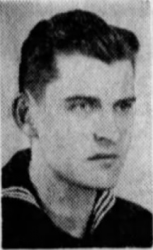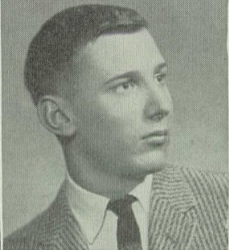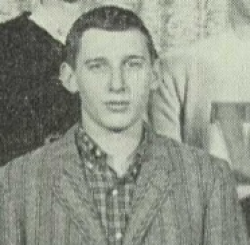
 |
|
|
||
|
ALFRED CHARLES MOYLE |
||||
|
Engagements: • World War II (1941 - 1945) |
||||
| Biography: | ||||
|
Alfred Charles was born in Oelwein, Fayette, IA on 12 Feb 1915 to Charles Arthur and Rena Mae (Wood) Moyle who married 07 Mar 1898 in West Union, Fayette, IA. Alfred’s only sibling was older sister Bernice Mae Hughson. Charles was a grocery store salesman for a number of years before he purchased the store himself and worked in it until his death in 1956. He was able to support his family through the Great Depression, but it was difficult for Alfred to secure even part-time employment to help with family expenses. According to newspaper reports, Alfred graduated from Oelwein High School about 1933. Graduation day that year was on 01 Jun 1933. According to the US census of 1940 for Waukegan, IL, Alfred reported that he had completed four years of high school as did his wife, Louise. Alfred, like so many youth of that era, felt duty-bound to help his family with finances during the Great Depression. He was also keen to learn a trade and find adventure. And, like many of his contemporaries, Alfred was lured to the opportunities of the US military services. He submitted a US Navy enlistment application in the fall of 1935 to the Naval Recruiting Station (NRS), Waterloo, Black Hawk, IA. He completed general aptitude examinations; submitted personal references; completed administrative paperwork and passed background checks. His father, Charles, signed the consent form as Alfred was not yet twenty-one years of age. Alfred’s final requirement before enlistment was to pass physical and dental examinations that were administered in the district NRS in Des Moines, Polk, IA. Alfred passed those examinations and was sworn into the US Navy (NSN: 321-01-00) on 12 Dec 1935 in Des Moines as an Apprentice Seaman (AS) for a period of four years. AS Moyle left Des Moines by train bound for the Naval Training Station (NTS) Great Lakes, IL arriving the next day. During recruit training, Moyle sat for another aptitude assessment. It indicated that Moyle qualified for the medical field as a Pharmacist’s Mate. He completed recruit training in early March 1936 and was granted 10 days of “Recruit Leave” to visit home before returning to NTS Great Lakes where he was assigned under instruction for about 4 months to the Hospital Corps Service School at NTS Great Lakes. He graduated from Hospital Corps School later that year receiving the designation as a Pharmacist’s Mate striker. He also advanced in rate to Hospital Apprentice Second Class (HA2c). During the next three years Moyle advanced in rate to Hospital Apprentice First Class (HA1c) then to Pharmacist’s Mate Third Class (PhM3c). He extended his first enlistment by two years in Oct 1939. He then advanced in rate to Pharmacist’s Mate Second Class (PhM2c) while assigned to the Naval Hospital at the NTS, Great Lakes, IL. Petty Officer Moyle advanced to PhM1c after arriving on the USS Pecos. In Dec 1939, PhM2 Moyle’s residence was in Waukegan, Lake, IL. He was granted leave from his duty station to return to his hometown in Iowa to marry Louisa Ann Marie Gumm on 17 Dec 1939 in Westgate, Fayette, IA. While still stationed at Great Lakes, Alfred’s wife, Louise, gave birth to a son, Frederick Charles Moyle, born (according to his IL birth certificate) 12 Dec 1940 in Waukegan, Lake, IL. Moyle reenlisted at NTS Great Lakes for another four years on 08 Oct 1941. Shortly thereafter, he received orders to report to Asiatic Station, Manila, Philippines for assignment. He detached from NTS Great Lakes in late October boarding a train bound for the Receiving Ship (R/S) in San Francisco, CA. On 10 Nov 1941, PhM2 Moyle detached from the R/S and embarked on the transport ship, USS Chaumont (AP-5). She was to be his ride across the Pacific to Asiatic Station at Manila, Philippines. His voyage across the Pacific was to be epic. The Chaumont got underway from San Francisco steaming under the new Golden Gate bridge on 13 Nov heading westward toward Pearl Harbor. She arrived in Pearl Harbor about 19 Nov. On 29 Nov 1941, Chaumont was underway from Pearl Harbor bound for the Philippines. She joined eight other ships that comprised a convoy. The flagship was the troop transport, USS Republic (AP-33). The convoy, generally known as the Pensacola Convoy for its escort ship, the heavy cruiser, USS Pensacola (CA-24) (also seen by the US Army as the "Republic Convoy"), included the gunboat, USS Niagara (PG-52), US Navy transports USS Republic (AP-33) and USS Chaumont (AP-5), the US Army transport USAT Willard A Holbrook and USAT Meigs; the US Merchant ships S.S. Admiral Halstead and S.S. Coast Farmer, and the Dutch merchant ship MS Bloemfontein. On board the convoy were 2600 US Army Air Forces personnel, On the Bloemfontein were eighteen crated Curtiss P-40 pursuit planes of the 35th Pursuit Group (PG) while forty-eight pursuit pilots of the 35th PG were embarked on the Republic and thirty-nine newly graduated but as yet unassigned pilots were on board the Holbrook. The presence of these planes and pilots would impact the destiny of the seaplane tender, USS Langley (AV-3), and the USS Edsall (DD-219). After war broke out, and Japanese forces attacked the Philippines, the convoy was diverted first to Suva, Fiji Islands. The convoy got underway on the 16th from Suva bound for Brisbane, Australia. Pensacola entered the harbor at Brisbane on 22 Dec 1941 and moored at Newstead Wharf. On the afternoon of 28 Dec, Pensacola, along with transports Chaumont (with PhM2 Moyle on board) and USAT Willard A. Holbrook got underway. On 2 Jan 1942, the Dutch ship MS Bloemfontein joined the convoy. The following morning (03 Jan 42) the convoy made passage through the Torres Strait above Cape York in far North Queensland, Australia. There they were joined by the heavy cruiser USS Houston (CA-30) and several destroyers including USS Edsall (DD-219). Houston relieved Pensacola as the convoy heavy escort, and with her destroyers and convoy ships proceeded to Darwin in the Northern Territory, Australia. Pensacola returned to Brisbane. On 07 Jan 1942, PhM2 Moyle disembarked from Chaumont in Darwin, Australia. Several days later, on 10 Jan 1942, Moyle reported for duty on board the fleet oiler, USS Pecos (AO-6). During January 1942, Pecos steamed to various locations around the Java sea refueling Allied warships. Beginning on 6 Feb 42, she was moored in Tjilatjap receiving fuel oil and pumping it into Dutch, British and American warships. Her commanding officer, Cdr Abernethy had attempted on multiple occasions to gain permission to get underway and head for the open sea as enemy Japanese forces moved rapidly south. The situation for a safe escape for Pecos became more improbable as each day came and went. Cdr Abernethy, Pecos' CO, knew his chances of escaping the Japanese carrier force prowling the Indian Ocean were slim. On 25 Feb, he refused to accept any wounded passengers who were not ambulatory and who could not take care of themselves. 1 He also had the foresight to bring aboard large numbers of Bamboo poles then lash them to the upper decks for flotation for swimmers if the ship was sunk. Finally, on 27 Feb, Pecos received orders to leave port in the morning to make room for the USS Langley that was expected to dock later in the morning. Three hours out of Tjilatjap Pecos radiomen intercepted some of Langley’s last radio transmission giving the tender’s position and condition (she was under attack by enemy aircraft). Within half an hour Pecos received word that Langley’s survivors were being picked up the destroyers, USS Edsall and USS Whipple. An hour later, Pecos received orders to proceed to Christmas Island, about 250 nm southwest of Tjilatjap to meet Edsall and Whipple to take on board survivors. Edsall rescued 177 survivors and Whipple rescued 308. Pecos was then to proceed to Exmouth Gulf off Australia’s west coast. Pecos already had survivors on board from USS Houston, Stewart and Marblehead taken on board in Tjilatjap. The added number of survivors would bring her on board count to over 700 personnel when Pecos’ normal complement was approximately 317 officers and enlisted crew. On 28 February, the two destroyers rendezvoused with the Pecos off Flying Fish Cove, Christmas Island. A sudden attack by land based Japanese bombers forced Pecos and the other ships to head for the open sea. They headed directly south into the Indian Ocean for the rest of 28 February in high winds and heavy seas. Early in the pre-dawn hours of 1 March, Whipple and Edsall transferred all the Langley survivors to Pecos. Whipple then set off for Cocos Islands as protection for the tanker Belita sent to meet her there. The Pecos, carrying a large number of survivors set course to Australia. Edsall had retained 32 USAAF personnel from Langley needed to assemble and fly an additional 27 P-40E fighters shipped to Tjilatjap aboard the transport Sea Witch. Edsall was instructed to return these "fighter crews" to Tjilatjap. At 0830, she reversed course and headed back to the northeast for Java. At noon that day, planes from Japanese aircraft carrier Soryu attacked Pecos and struck again an hour later. Finally, in mid-afternoon, third and fourth strikes from aircraft carriers Hiryu and Akagi fatally wounded the Pecos. While under attack, Pecos radioed for help. After she sank, Whipple returned to the scene intentionally arriving after dark. She eventually rescued 232 survivors. Many other survivors, although visible to crewmembers on board Whipple, had to be abandoned at sea because Whipple made sonar contact with what was believed to be several Japanese submarines. It was just too dangerous for her to remain in the area. She steamed to Australia where she safely arrived in Fremantle, Australia on 04 Mar 1942. PhM2 Moyle was listed as missing in action on 01 Mar 1942. His remains were unrecoverable. He was presumed dead on 15 Dec 1945. Moyle’s advancement in rate to PhM1 was recognized in a SECNAV Letter of Commendation reported in several newspapers and in BUPERS Information Bulletin (Currently called All Hands Magazine) #306 Sept 1942 (p.21), Alfred Charles Moyle, Pharmacist’s Mate 1st Class, U.S.N. was one of 28 men who received a letter of commendation from Secretary of the Navy Frank Knox for heroism and for outstanding performance of duty when the USS Pecos was sunk by the Japanese in waters south of Java. PhM1 Moyle was commended for “Cooley, calmly, and bravely performing all duties in an outstanding manner throughout the action.” Moyle was also (posthumously) awarded the Purple Heart, American Defense Service Medal with Fleet Clasp, Asiatic-Pacific Campaign Medal with Fleet Clasp (one bronze star in lieu of fleet clasp) and second bronze star, and the World War II Victory Medal. He may have earned the Good Conduct Ribbon for his first enlistment and the Combat Action Ribbon. Several months after Petty Officer Moyle was declared dead in Dec 1945 Mrs Moyle married James R. Blackledge about Apr 1946. They were the parents of four sons. Frederick Charles Moyle, Alfred's only child, was presumably adopted by James Blackledge because Frederick used that name during high school. Louisa Gumm Blackledge died 09 Sep 1997 in Westgate, Fayette, IA. ------------------------ A commemoration in honor of PhM1 Moyle’s service from President Harry S. Truman reads: In Grateful Memory of Alfred Charles Moyle, Who Died In The Service Of His Country At Sea, Asiatic Area, attached U.S.S. Pecos, 15 December 1945 (presumed). He stands in the unbroken line of patriots who have dared to die that freedom might live, and grow, and increase its blessings. Freedom lives, and through it, he lives – in a way that humbles the undertakings of most men. Signed, Harry Truman President of the United States of America -------------------------- [Bio #342 composed by Gerry Lawton (GML470/G47)] Find A Grave Memorial Page#233524840 ------------------ Partial list of sources: 1)Messimer, Dwight R. Pawns of War: the Loss of the USS Langley and the USS Pecos. Annapolis, Maryland: Naval Institute Press . 1983. 2) Kehn, Donald M., Jr. A Blue Sea of Blood. Minneapolis: Zenith Press, 2008 3) Kehn, Donald M., Jr. In the Highest Degree Tragic: The Sacrifice of the U.S. Asiatic Fleet in the East Indies during World War II. Potomac Books, University of Nebraska Press. 2017 4) Various Navy Muster and Change reports, Ancestry.com and Fold3.com 5) Various newspaper articles 6) USS Pecos and USS Whipple Wiki pages on-line. |
||||
| Honoree ID: 153232 | Created by: MHOH | |||
Ribbons
Medals
Badges
Honoree Photos
 |  |  |
 |  |
 |


